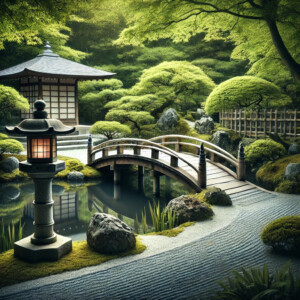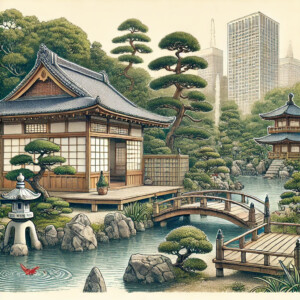1. Introduction
Japanese gardens are a quintessential expression of the country’s aesthetic values, spiritual beliefs, and cultural history. These meticulously designed spaces are not merely collections of plants and rocks; they are profound reflections of the Japanese way of seeing the world. Japanese gardens emphasize harmony between man and nature, aiming to create a peaceful environment that fosters contemplation and inner tranquility. This article explores the various types of Japanese gardens, their unique elements, and their cultural significance, revealing how these beautiful spaces continue to inspire people around the world.
2. Types of Japanese Gardens

Karesansui (Zen Gardens)
- Features and Symbolic Meanings: Karesansui, or Zen gardens, are perhaps the most iconic of Japanese garden styles. These gardens are characterized by their minimalist design, using rocks, gravel, and sand to represent natural elements like mountains, rivers, and the sea. Unlike other garden types, Zen gardens typically do not include water. Instead, raked gravel or sand symbolizes water’s flowing nature. The deliberate placement of rocks and the careful raking of gravel into patterns are intended to evoke a sense of calm and reflection, offering a physical representation of Zen Buddhist principles such as simplicity, tranquility, and impermanence.
- Famous Examples: One of the most famous Zen gardens is the Ryoan-ji Temple garden in Kyoto. This garden features 15 rocks of varying sizes arranged on a bed of white gravel. The precise placement of the rocks creates an illusion that from any vantage point, one rock is always hidden from view, symbolizing the incompleteness of our understanding and the importance of continuous learning and meditation.
Chaniwa (Tea Gardens)
- Connection with the Japanese Tea Ceremony: Chaniwa, or tea gardens, are closely linked with the traditional Japanese tea ceremony (chanoyu). These gardens are designed to create an atmosphere of serenity and preparation as guests approach the tea house. The layout of a tea garden is deliberately simple, guiding visitors along a path that encourages a slow, mindful walk. The path often includes stepping stones, which symbolize the progression toward spiritual purity.
- Elements: Tea gardens often include several key features: stone lanterns (toro), water basins (tsukubai), and rustic gates. The lanterns provide soft illumination, adding to the garden’s serene ambiance, while the water basins are used by guests to purify themselves before entering the tea house, symbolizing the cleansing of the mind and spirit. The garden’s natural and understated design, with elements like moss-covered stones and carefully pruned trees, creates a sense of timelessness and tranquility, making it the perfect prelude to the tea ceremony, which itself is a deeply meditative practice.
Kaiyu-shiki (Strolling Gardens)
- Designed for Walking and Viewing: Kaiyu-shiki, or strolling gardens, are designed for leisurely walking and contemplation. Unlike Zen or tea gardens, which are meant to be viewed from a single point, strolling gardens are meant to be experienced through movement. As visitors follow winding paths, new views and scenes unfold, offering different perspectives on the garden’s landscape. These gardens often feature large ponds, islands, bridges, and artificial hills, creating a miniature, idealized version of the natural world.
- Famous Examples: Kenrokuen in Kanazawa is one of Japan’s most celebrated strolling gardens. Its name, meaning “Garden of the Six Sublimities,” refers to the six attributes considered necessary for the perfect garden: spaciousness, seclusion, artificiality, antiquity, water courses, and panoramic views. Another famous strolling garden is Korakuen in Okayama, which was designed to be enjoyed in all seasons, with carefully selected plants that provide beautiful displays of color and texture throughout the year.
3. Elements of Japanese Gardens

Water Features
- Ponds, Streams, and Waterfalls: Water is a central element in many Japanese gardens, symbolizing the flow of life and the passage of time. Ponds and streams are often designed to reflect the natural landscape, with their shapes and the placement of rocks and plants carefully arranged to create the illusion of a natural, untouched environment. Waterfalls, another common feature, add movement and sound to the garden, enhancing the sensory experience and contributing to the overall atmosphere of peace and tranquility. The presence of water also serves a symbolic purpose, representing purification and the ever-changing nature of life.
Rocks and Gravel
- Symbolism and Placement: Rocks and gravel are fundamental elements in Japanese garden design, often representing mountains, islands, or even deities. The careful placement of rocks is considered an art form in itself, with each rock selected for its shape, texture, and color, and positioned to create a specific visual and symbolic effect. In Zen gardens, gravel is raked into patterns that evoke waves or ripples in water, encouraging meditation on the natural forces that shape our world. The interplay between solid, unchanging rocks and the flowing patterns of gravel mirrors the balance between permanence and change, a key concept in Japanese aesthetics.
Plants and Trees
- Seasonal Changes and Their Significance: Plants and trees in Japanese gardens are chosen not only for their beauty but also for their symbolic meanings and their ability to mark the changing seasons. Cherry blossoms, for example, are celebrated for their fleeting beauty, symbolizing the impermanence of life. Maple trees, with their vibrant autumn colors, represent the maturity and wisdom that come with age. The careful selection and placement of plants ensure that the garden offers something beautiful to look at in every season, whether it’s the fresh green of spring, the lush growth of summer, the fiery hues of autumn, or the stark beauty of winter.
Lanterns and Bridges
- Aesthetic and Functional Roles: Stone lanterns and bridges are iconic features of Japanese gardens, serving both aesthetic and practical purposes. Lanterns, often placed near water features or along garden paths, provide gentle illumination that enhances the garden’s atmosphere, especially at dusk. Bridges, whether simple wooden structures or more elaborate stone designs, connect different parts of the garden and symbolize the journey of life. Crossing a bridge in a Japanese garden is often seen as a metaphor for moving from one state of being to another, reflecting the transformative power of nature and the passage of time.
4. The Cultural Significance of Gardens

Gardens as a Reflection of Japanese Aesthetics and Philosophy
- Japanese gardens are deeply rooted in the country’s cultural and philosophical traditions, particularly the principles of wabi-sabi (the beauty of imperfection) and mono no aware (the awareness of the impermanence of things). The simplicity, naturalness, and subtle elegance of Japanese garden design reflect these concepts, encouraging visitors to find beauty in the fleeting and the imperfect. The gardens are designed to evoke a sense of tranquility and contemplation, offering a space where one can connect with nature and reflect on the deeper meanings of life.
The Role of Gardens in Promoting Mindfulness and Tranquility
- Japanese gardens are not just places of beauty; they are spaces designed to promote mindfulness and inner peace. The act of walking through a garden, pausing to admire a flower or listen to the sound of water, encourages a slowing down of time and a deepening of awareness. The garden becomes a sanctuary from the noise and distractions of daily life, offering a chance to reconnect with oneself and the natural world. In this way, Japanese gardens serve as a form of moving meditation, where the simple act of being present in the garden can lead to a profound sense of calm and clarity.
Gardens as a Place for Seasonal Festivals and Cultural Events
- Japanese gardens have long been associated with seasonal festivals and cultural events, from hanami (cherry blossom viewing) in spring to moon-viewing parties in autumn. These events are opportunities to celebrate the changing seasons and the beauty of nature, with the garden providing a perfect setting for these communal activities. The cyclical nature of the seasons, as reflected in the garden, reminds us of the impermanence of life and the importance of living in harmony with the natural world.
5. Famous Japanese Gardens Around the World

Influence of Japanese Garden Design Globally
- The principles of Japanese garden design have had a profound influence on landscape architecture around the world. Many countries have embraced the Japanese aesthetic, incorporating elements like Zen gardens, koi ponds, and tea houses into public and private gardens. This global appreciation for Japanese gardens is a testament to their universal appeal and their ability to evoke a sense of peace and harmony, regardless of cultural context.
Examples of Japanese Gardens Outside Japan
- Japanese gardens can be found in cities across the globe, each offering a slice of Japan’s natural beauty and tranquility. The Japanese Tea Garden in San Francisco, the Portland Japanese Garden, and the Japanese Garden at the Huntington Library in Los Angeles are all famous examples. These gardens serve as cultural ambassadors, introducing the philosophy and aesthetics of Japanese garden design to a global audience. They are popular destinations for those seeking a peaceful retreat from urban life and a deeper connection with nature.
6. Conclusion
Japanese gardens are more than just beautiful spaces; they are profound expressions of cultural values, philosophical concepts, and artistic creativity. Whether it is a Zen garden designed for meditation, a tea garden leading to a tranquil tea house, or a strolling garden that offers new perspectives with every turn, each type of Japanese garden has its own unique charm and significance. As you explore these gardens, you are invited to slow down, observe the changing seasons, and reflect on the deeper meanings behind the carefully arranged stones, flowing water, and rustling leaves. In a world that often feels chaotic and fast-paced, Japanese gardens offer a sanctuary of peace, beauty, and timeless wisdom.
Comment